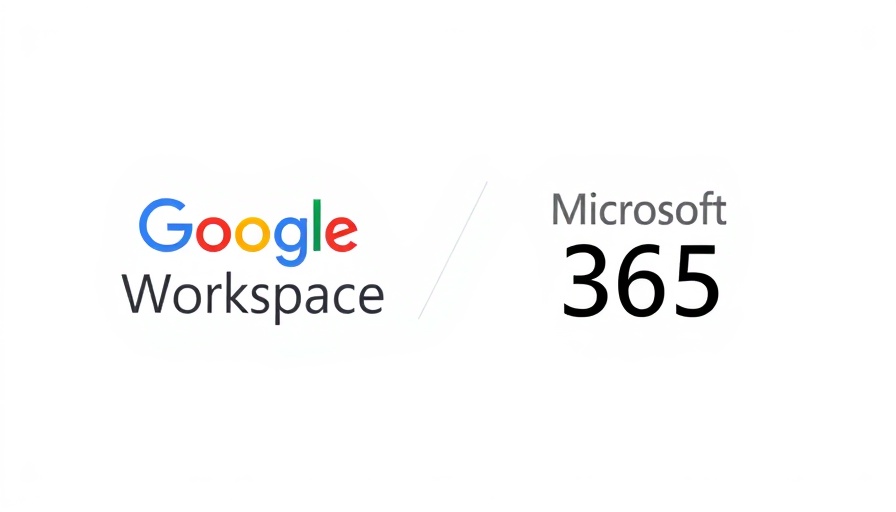
Google Workspace vs Office 365: The Showdown for 2025
As we head into 2025, small business owners and managers are faced with the crucial choice between two of the industry's giants: Google Workspace and Office 365. These platforms have evolved to become more than just productivity tools; they embody almost everything modern businessmen need to enhance their workflow.
Understanding the Core Differences
Throughout the years, both Google Workspace and Office 365 have made significant strides in features and usability. Google Workspace is renowned for its real-time collaboration capabilities, which make it exceedingly useful for teams that require immediate updates on shared documents and spreadsheets. Alternatively, Office 365 has fortified its position by offering advanced email features, stringent security measures, and business tools designed for larger organizations. If your business consists of remote teams or beginners, Google Workspace could provide the easier and more effective platform. However, if your operations require more intricate configurations and automation, Office 365 remains the frontrunner.
The Cost Factor: Value for Money
When analyzing Google Workspace versus Office 365, the cost往始 becomes a critical point of discussion. Google Workspace offers a tiered pricing structure that is typically viewed as cost-effective for small to medium-sized enterprises while still providing essential features. Office 365, on the other hand, may appear pricier upfront but includes in-depth integrations and functionalities that make it worth the investment for larger teams. This leads us to understand that budget considerations should reflect not just cost but what your business fundamentally requires.
Security: Protecting Your Business
Data breaches and cyber threats have spurred conversations surrounding cybersecurity in the digital workspace. Both platforms invest heavily in enterprise-grade security measures. Office 365 often scores higher on this front, providing comprehensive security features tailored for larger organizations that handle sensitive information. However, Google Workspace isn’t left behind; it offers robust security options including AI-driven protection. Depending on your business model, you need to decide which security measures align with your priorities.
The Future of Digital Collaboration
Looking forward, businesses must embrace the future of digital collaboration in a post-pandemic world. Google has made headway with AI-driven tools such as Gemini, facilitating tasks like content creation and analytics. Office 365 also has introduced enhanced features, underlining its adaptability in changing work patterns. These developments indicate a trend toward more integrated, intelligent solutions designed to meet evolving business needs.
Language Accessibility and User Experience
A significant factor influencing the preference toward one platform over the other may be the user experience. Google Workspace’s simplistic and intuitive interface attracts many users, particularly those less tech-savvy. Meanwhile, Office 365 may require a steeper learning curve for new users but rewards them with expansive features once mastered. Understanding how your team interacts with technology is paramount in leveraging productivity tools to their full potential.
Common Misconceptions: Deconstructing Myths
Misconceptions often cloud decision-making. One prevalent myth is that Office 365 is exclusively for large businesses and complex needs. In truth, Office 365 has dynamic pricing options to accommodate small businesses as well. Conversely, some may think Google Workspace lacks depth. While its strengths lie in collaboration, it also offers robust functionalities that can easily compete with Office 365 for daily business operations.
Practical Tips for Decision-Making
As you near a decision, consider creating a checklist of what matters most for your business. Key points should include:
Feature requirements: What tools does your team need for daily operations?
Team size and growth potential: Are you expecting substantial growth that might affect the platform's scalability?
Budget constraints: How much are you willing to invest in tools for efficiency?
Integration needs: Does one platform integrate better into your current systems?
Support services: Evaluate the level of customer service and support functions available.
Such criteria will guide you in choosing the tool that caters best to your needs.
Conclusion: Make the Right Choice for 2025
If you're a small business owner or manager, your decision should not be taken lightly. Neither Google Workspace nor Office 365 is universally superior; rather, the choice depends on specific business needs and future plans. Leverage their trial periods to fully evaluate which platform feels right for your team before making a commitment. The future of your workplace productivity hinges on this pivotal choice, so choose wisely and stay ahead.
Want to stay updated on the latest trends in digital tools for productivity? Sign up for our Marketing Newsletter today!
 Add Row
Add Row  Add
Add 




Write A Comment